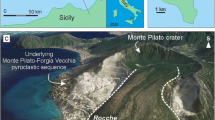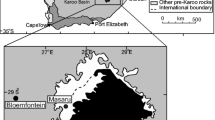Abstract
Etna’s 2001 basaltic lava flow provided a good example of the distal flow segment between the flow front and stable channel, across which the flow evolves from channel-contained to dispersed. This zone was mapped with meter precision using LIDAR data collected during 2004 and 2005. These data, supported by field mapping, show that the flow front comprised eight lobes each 10 to 20 m high. The flow front appears to have advanced not as a single unit, but as a series of lobes moving forward one lobe at a time. Primary lobes were centered on the channel axis and marginal lobes were off-axis. The lobes advanced as breakouts of low-yield-strength lava from the flow core of the stalled flow front. Marginal lobes were abandoned and contributed to marginal levees flanking the transitional channel. For Etna’s 2001 flow, the transitional channel is 140 m wide, 700 m long and fed a 240-m-long zone of dispersed flow; the change from stable to transitional channel occurred at a major reduction in slope. Above this, the stable channel is 5.2 km long, 55 to 105 m wide and bounded by 15- to 25-m-high levees, and the stable channel is located over a previous channel. In a final stage of activity, lava ponding at the break-in-slope that marks the terminus of the stable channel put pressure on the eastern levee, causing it to fail. Liberated lava then fed a final break-out to the east. Similar flow front-features occur at other volcanoes, indicating that similar processes are characteristic of dispersed flow zones.






Similar content being viewed by others
References
Bailey JE, Harris AJL, Dehn J, Calvari S, Rowland SK (2006) The changing morphology of an open lava channel on Mt. Etna. Bull Volcanol 68:497–515. doi:10.1007/s00445-005-0025-6
Baloga SM, Glaze LS (2008) A self-replication model for long channelized lava flows on the Mars plains. J Geophys Res 113:E05003. doi:10.1029/2007JE002954
Behncke B, Neri M (2003) The July—August 2001 eruption of Mt. Etna (Sicily). Bull Volcanol 65:461–476. doi:10.1007/s00445-003-0274-1
Borgia A, Linneman SR (1990) On the mechanism of lava flow emplacement and volcano growth: Arenal, Costa Rica. In: Fink JH (ed) Lava flows and domes. Springer, Berlin, pp 208–243
Borgia A, Linneman S, Spencer D, Diego Morales L, Brenes Andres J (1983) Dynamics of lava flow fronts, Arenal Volcano, Costa Rica. J Volcanol Geotherm Res 19:303–329
Bottinga Y, Weill DF (1970) Densities of liquid silicate systems calculated from partial molar volumes of oxide components. Am J Sci 269:169–182
Calvari S, Pinkerton H (1998) Formation of lava tubes and extensive flow field during the 1991–1993 eruption of Mount Etna. J Geophys Res 103(B11):27291–27301
Cigolini C, Borgia A, Casertano L (1984) Intra-crater activity, aa-block lava, viscosity and flow dynamics: Arenal Volcano, Costa Rica. J Volcanol Geotherm Res 20:155–176
Coltelli M, Proietti C, Branca S, Marsella M, Andronico D, Lodato L (2007) Analysis of the 2001 lava flow eruption of Mt. Etna from three-dimensional mapping. J Geophys Res 112:F02029. doi:10.1029/2006JF000598
Corsaro RA, Miraglia M, Pompilio M (2007) Petrologic evidence of a complex plumbing system feeding the July–August 2001 eruption of Mt. Etna, Sicily, Italy. Bull Volcanol 69:401–421
Dragoni M, Tallarico A (1996) A model for the opening of ephemeral vents in a stationary lava flow. J Volcanol Geotherm Res 74:39–47
Dragoni M, Borsari I, Tallarico A (2005) A model for the shape of lava flow fronts. J Geophys Res 110:B09203. doi:10.1029/2004JB003523
Fink JH, Zimbelman JR (1986) Rheology of the 1983 Royal Gardens basalt flows, Kilauea Volcano, Hawaii. Bull Volcanol 48:87–96
Harris AJL, Flynn LP, Matías O, Rose WI (2002) The thermal stealth flows of Santiaguito: implications for the cooling and emplacement of dacitic block lava flows. Geol Soc Am Bull 114:533–546
Harris AJL, Flynn LP, Matias O, Rose WI, Cornejo J (2004) The evolution of an active silicic lava flow field: An ETM+ perspective. J Volcanol Geotherm Res 135:147–168
Harris A, Bailey J, Calvari S, Dehn J (2005) Heat loss measured at a lava channel and its implications for down-channel cooling and rheology. Geol Soc Am Spec Pap 396:125–146
INGV Catania Research Staff (2001) Multidisciplinary approach yields insight into Mt. Etna eruption. EOS Trans AGU 82(52):653–656
Kilburn CRJ, Guest JE (1993) Aa lavas of Mount Etna, Sicily. In: Kilburn CRJ, Luongo G (eds) Active lavas: Monitoring and modeling. UCL, London, pp 73–106
Lipman PW, Banks NG (1987) Aa flow dynamics, Mauna Loa. UGSG Prof Pap 1350:1527–1567
Macdonald GA (1953) Pahoehoe, aa, and block lava. Am J Sci 251:169–191
Mazzarini F, Pareschi MT, Favalli M, Isola I, Tarquini S, Boschi E (2005) Morphology of basaltic lava channels during the Mt. Etna September 2004 eruption from airborne laser altimeter data. Geophys Res Lett 32:L04305. doi:10.1029/2004GL021815
Mazzarini F, Pareschi MT, Favalli M, Isola I, Tarquini S, Boschi E (2007) Lava flow identification and aging by means of LiDAR intensity: the Mt. Etna case. J Geophys Res 112:B02201. doi:10.1029/2005JB004166
Neri M, Mazzarini F, Tarquini S, Bisson M, Isola I, Behncke B, Pareschi MT (2008) The changing face of Mount Etnas summit area documented with Lidar technology. Geophys Res Lett 35:L09305. doi:10.1029/2008GL033740
Rowland SK, Walker GPL (1987) Toothpaste lava: Characteristics and origin of a lava structural type transitional between pahoehoe and aa. Bull Volcanol 49:631–641
Sparks RSJ, Pinkerton H, Hulme G (1976) Classification and formation of lava levees on Mount Etna, Sicily. Geology 4:269–271
Tallarico A, Dragoni M (1999) Viscous Newtonian laminar flow in a rectangular channel: application to Etna lava flows. Bull Volcanol 61:40–47
Tarquini S, Isola I, Favalli M, Mazzarini F, Bisson M, Pareschi MT, Boschi E (2007) TINITALY/01: a new triangular irregular network of Italy. Annals of Geophysics 50(3):407–425
Wadge G, Lopes RMC (1991) The lobes of lava flows on Earth and Olympus Mons, Mars. Bull Volcanol 54:10–24
Acknowledgement
We are grateful to two reviewers (John Bailey and Anonymous) for their helpful comments, as well as to Jane Applegarth for discussions and suggestions that greatly improved this paper.
Author information
Authors and Affiliations
Corresponding author
Additional information
Editorial responsibility: J. McPhie
Rights and permissions
About this article
Cite this article
Favalli, M., Harris, A.J.L., Fornaciai, A. et al. The distal segment of Etna’s 2001 basaltic lava flow. Bull Volcanol 72, 119–127 (2010). https://doi.org/10.1007/s00445-009-0300-z
Received:
Accepted:
Published:
Issue Date:
DOI: https://doi.org/10.1007/s00445-009-0300-z




